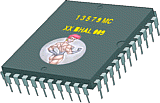
Processor Design
An Introduction
Hardware Scaling, Hardware Scrolling, 64-bit data paths and high MHZ processors are all things that we know make video games better... but how do these work?
In this installment of The Math Behind the Magic, we will be taking a look at how a computer works, down to the basic boolean algebra. To begin with, we need to take a look at how boolean algebra works, this will lead us into truth tables, and simple schematics. Building from these schematics we will look at Karnaugh maps, and higer level implementation. This higher level implementation will then be used to create an Arithmetic Logic Unit--the brains in a computer. We will end by desiging some simple memory schemes, the final stage in building a processor. By the end of this article, we will design a fully functional processor.
- Join in now! Since this article really covers several different levels, I've split them up according to topic. If you already understand a topic, feel free to skip around. If you are a novice to processor design, you'll probably get the most by starting at the first section, and following the leaders until the end.
 Start by getting a grasp on Boolean Algebra.
Start by getting a grasp on Boolean Algebra. Learn to build simple combinational logic circuits, and use K-Maps.
Learn to build simple combinational logic circuits, and use K-Maps. An introduction to the Microprocessor
An introduction to the Microprocessor Build the Brainless Microprocessor, A microprocessor concept overview.
Build the Brainless Microprocessor, A microprocessor concept overview. Build the Brainless Microprocessor, Designing our 4bit addition unit.
Build the Brainless Microprocessor, Designing our 4bit addition unit. Build the Brainless Microprocessor, Designing a Multiplexer/Demultiplexer to control flow.
Build the Brainless Microprocessor, Designing a Multiplexer/Demultiplexer to control flow. Build the Brainless Microprocessor, Making the ALU.
Build the Brainless Microprocessor, Making the ALU. Build the Brainless Microprocessor, Adding Registers, and a Data Bus.
Build the Brainless Microprocessor, Adding Registers, and a Data Bus. Brain Surgery: It's Alive, Adding an instruction decoder.
Brain Surgery: It's Alive, Adding an instruction decoder. Next time: What it takes to use our processor as a Game Console
Next time: What it takes to use our processor as a Game Console
[ New Contents ]
[ Classic Contents - Articles - Reviews - Comics - Codes ]

